City Talk
During the last two weeks, I talked about Ravnica Allegiance's design. In those articles, I focused more on the mechanics. Now it's time to start talking about individual cards.
Absorb
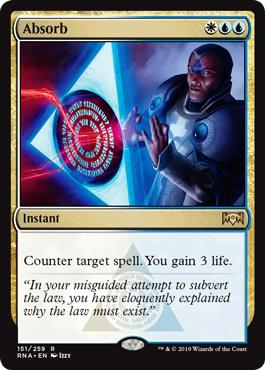
Invasion was the first set to have a multicolor theme. Previous sets had had multicolored cards, but never in the volume that Invasion was offering up. One of the challenges of designing that many multicolor cards was trying to make sure we could make ones that weren't too wordy. Multicolor cards need to feel relevant to each of the colors in its mana cost, and that can lead to lengthy rules text.
Absorb and Undermine were designed during our pass to make less wordy, elegant, yet still exciting gold cards. I believe we originally designed them as uncommon cards, but playtesting showed that if we wanted to push them for Constructed, they made more sense as rares. (As you go up in rarity, you get more spell for your mana cost; this is done because Limited cards don't want to be as aggressively costed. For example, killing a creature wants to cost four to five mana in Limited, but only two mana in Constructed.)
We liked the mirror pairing of these cards, so we costed them at the same converted mana cost (two blue and one of the appropriate color—back in the day, all hard counters had to cost UU; nowadays, the rule is that it just has to have two colored mana in its cost, one of which has to be blue), and had the life loss and gain be the same. As history has shown, time and again, making people lose life is stronger than you gaining life, so Undermine ended up being bit stronger.
Flash forward to Ravnica Allegiance design. With all sets, we like to look for flavorful reprints to bring back. Our favorites are ones that we know players would enjoy but haven't been reprinted often. Early on, Absorb came up. We knew we didn't want to reprint Undermine, but there was a lot of talk about how Absorb might be okay. The card had never been reprinted since Invasion (Undermine had been in a 2001 World Championship deck and Duel Decks: Ajani vs. Nicol Bolas), so it seemed like the perfect reprint. The card got added early in design, although we were aware that Play Design might pull it at any time. Luckily, they never felt the need to do so, and the card ended up in the set.
Angel of Grace
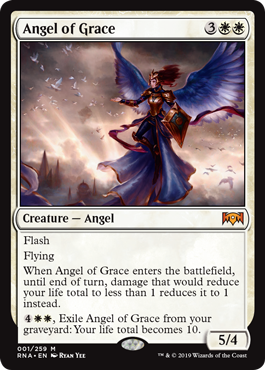
Whenever we make a card with an evergreen keyword not normally seen in that color, I get questions about it. For example, flash is primary in blue and secondary in black and green. What is it doing on a white card? The answer is that certain keywords (defender, flash, flying, haste, and trample) are allowed in all five colors under certain conditions. Let's walk through them.
Defender – Defender is the only evergreen keyword that's a restriction. The reason it's keyworded is that it's useful enough to us that we use it in a volume where keywording makes sense. The reason we split up abilities between colors is to encourage people to stretch into other colors. There's no reason to stretch for a restriction, so there's no great sense isolating it to certain colors. Plus, every color has creatures and interacts with combat in a way where having access to the keyword as a tool is valuable.
Flash – Flash is probably the evergreen keyword closest to not being a keyword. As I've often said, if I could rewrite history, instant would be a supertype and flash wouldn't exist. Flash is a tool. We do concentrate it in certain colors because it helps us give those colors a tactical advantage that adds flavor and mechanical depth. The reason we allow all colors access to it is that there are cool designs that only work if a creature has access to flash. For instance, Angel of Grace couldn't have that "enters-the-battlefield" effect if it was a creature that could only be cast during your main phase. So, we make a special exception for red and white to be able to use flash when it's essential to the design of the card. They have the ability tertiary, which means we don't do it a lot or often at lower rarities, but it's something we'll use when needed.
Flying – White, blue, and black get flying all the time. Red gets it on Dragons and Phoenixes. Green doesn't normally get it, but it's something that we allow green (and red for non-Dragons and non-Phoenixes) access to every once in a while, when it's really needed (for example, we're doing a Dragon-themed set and want to do a cycle of monocolor Dragons).
Haste – Haste is probably the most tool-like evergreen mechanic after flash. There are times we make mechanics where the audience assumes they can attack with the creature, and it's easier to just let them than try to spend a lot of words convincing them they can't. (Suspend and awaken are two good examples.) Because of this, we let white and blue—the two colors that don't have haste primary or secondary—occasionally have access.
Trample – If you're big enough, no matter what color, we occasionally will let you have access to trample, the least in white as that's the color least likely to have giant creatures.
Benthic Biomancer
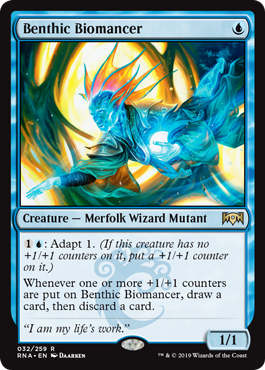
In the preview article where I talked about adapt, I explained why we didn't just use monstrosity. One of the reasons I gave is that it opened up the mechanic to have more synergy with Simic's +1/+1 counter theme. Benthic Biomancer is a great example of this design space. The card is a 1/1 that can later become a 2/2, but that's not really what makes this card shine. You can use this card as a means to turn +1/+1 counters into looting. Or, if you have some means to remove the +1/+1 counter off of Benthic Biomancer, you can create a looting engine. It creates a dynamic that never appeared on any of the monstrosity cards, and it makes the mechanic feel a lot more Simic-y.
Biogenic Ooze
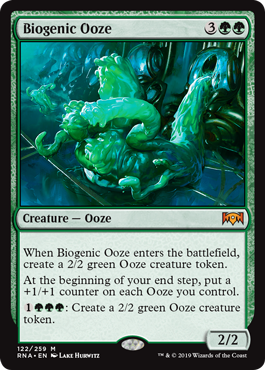
My greatest regret of co-leading the design for Gatecrash is that I didn't make an Ooze lord. I've always been a big fan of Oozes, and I was aware that they deserved a lord. I kicked myself for not figuring out that the Simic is the perfect place to make an Ooze lord. I've looked elsewhere to put one, but nothing was as perfect a fit for an Ooze lord as a Ravnica set with the Simic.
So, one of my goals when I started Ravnica Allegiance vision design was to make one. And we did. Not Biogenic Ooze, mind you. It was a different design, but when I handed off the file to Sam Stoddard, who was the Set Design lead, I asked him for just one thing. I said, "Please, can you make sure the set has an Ooze lord." It doesn't have to be the one Vision Design made, just a design that he and his team liked. Sam said he would, and, as Biogenic Ooze demonstrates, Sam is a man of his word.
The thing I enjoy about the card's design is that it works just fine in a vacuum, in a deck that has zero other Oozes, because it can generate its own Oozes, but it's designed to be a perfect card for an Ooze deck.
So, Ooze lovers, I (and Sam) have your back. Please enjoy your Ooze lord.
Biogenic Upgrade

This is the kind of design I enjoy—for many reasons. One, I'm a huge fan of +1/+1 counters (as anyone who's played any of my designs should probably know). Two, I love doubling. Three, I really enjoy when a card can work on different levels and be enjoyable at all of those levels. (Biogenic Ooze does this as well.) In a vacuum, the card allows you to create six +1/+1 counters, which can be distributed in even amounts to up to three creatures. Mix the card into a deck that has a +1/+1 counter theme, though, and you can have even more fun because the spell doesn't just copy the +1/+1 counters generated by this spell but any on creatures targeted by this spell (up to three, obviously). This is a great example of a lenticular design that encourages a player to mix and match it with other cards if they see the combination. If not, the card works just fine all by itself.
Bring to Trial

This is one of those cards that at first blush you think is a reprint with a new name. Magic does this effect all the time. Surely, we've done this before. It's Smite the Monstrous, right? No, that's an instant that costs 3W. Is it Reprisal? No, that costs one less, is an instant, and keeps the creature from regenerating. Is it Bring Down, Collective Effort, Humble the Brute, Radiant's Judgment, or Smite the Foul? No, those all have extra mechanics on them. Okay, it's Legion's Judgment. Close, but Bring to Trial exiles where Legion's Judgment destroys. White has plenty of effects that exile creatures, but not many that have a power restriction. (Last Breath being the only one, and that's power 2 or less—white no longer targets small creatures specifically for destruction.) I believe exiled was used here as an answer for afterlife, the Orzhov mechanic.
Domri, Chaos Bringer
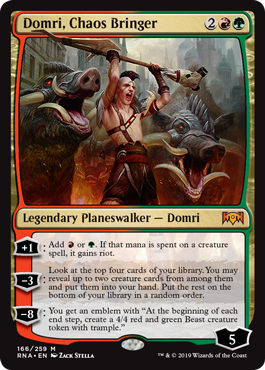
The story dictated who the Planeswalkers for Ravnica Allegiance were going to be, so Design's job was to make cool new versions. Domri Rade only has one previous planeswalker card (Domri Rade from Gatecrash), so we had a decent amount of room to play around in. Domri's shtick is threefold: One, he's young. Up until the introduction of Aminatou, he was the only kid Planeswalker (although a teen and not a child). Two, he mechanically cares about creatures, more so larger creatures. Three, he's a bit of an anarchist (and from Ravnica). The middle one is the most mechanically relevant.
For the +1 ability, we wanted something that helped enable you to play creatures. Red and green are the two colors with mana production, so granting you mana seemed appropriate. To get a little of the anarchy in and to tie it to Gruul, as Domri is the leader of the guild put in that role by Bolas, we chose to give the creatures cast with that mana riot. Two things about that: One, whenever we tie abilities to mana usage, we have to talk with digital because that's one of the areas that can cause problems. Two, early on, we tended to avoid tying Planeswalkers to set mechanics as we liked to have them feel independent of the worlds they were on. As planeswalker design space gets tighter and as the stories more tightly connect the Planeswalkers to the set, we've changed our attitude and are now trying to find more ways to use set mechanics on planeswalker cards. We've accepted, due to text restrictions on planeswalker cards and the fact that they're mythic rare, that we will often skip reminder text on them for those abilities.
The -3 ability is something you can use to help you get creatures if you don't have any. We've moved away from tutoring to top of library interactions because it creates less repetition of play. Also, it encourages you to play a deck that's denser in the thing you're trying to find. We allowed you to keep two or more of them, so there is a big enough upside to play a lot of creatures. The rest of the cards go on the bottom of the library in a random order instead of a chosen order because our rule is to make it random whenever there's a chance that you'll be putting three or more cards there. The thought behind this rule is that we don't want players spending time making decisions that won't ever matter in the vast majority of games.
Domri's ultimate plays into his creature theme by producing 4/4 Beasts. It's the kind of condition that can help you win the game, and it also plays nicely with Domri's other planeswalker card with the dream of getting both ultimate emblems on the battlefield.
Dovin, Grand Arbiter
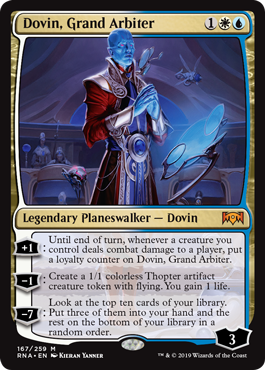
Dovin Baan was another Planeswalker that previously only had one planeswalker card (in Kaladesh). Dovin's shtick is twofold: One, he's a vedalken from Kaladesh that works for the government. Two, his special ability is that he can sense weaknesses in things and then take advantage of them. His Kaladesh planeswalker card pushed heavily into being a control card with the means to make it harder for your opponent to do things.
Dovin's Ravnica Allegiance card pushes in a little different direction to make it play well with how Azorius works in the set. His +1 ability allows you to turn combat damage to players into loyalty. This is important because his ultimate is a strong card-drawing ability that not only allows you to draw lots of cards, but also gives you selection to optimize those draws. This first ability is mainly a means to help fuel the other abilities, especially the ultimate.
His -1 ability is a means to help you with the first ability in case you don't have any creatures that can successfully deal combat damage. The choice of an artifact Thopter token is a nice nod to the fact that Dovin is from Kaladesh, as Thopters aren't a thing on Ravnica. It also allows the deck to have some artifact synergy, another nod to Kaladesh. The life gain rider is meant to help both tie to his previous card and give some small means of defense.
The ultimate also ties into Dovin's original card and allows the card to enable more synergistic strategies as you get a lot of selection with your card draw. Dovin couldn't easily have the Azorius mechanic as it's tied to instants.
Electrodominance
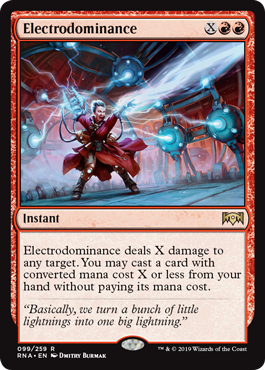
This card caused some discussion in the Council of Colors. Obviously red can deal damage, but casting any spell from your hand without paying its mana cost is less straightforward. Yes, red has some experience casting instants and sorceries from your hand for free, but the Design team felt that was too restrictive for this card. They wanted it to be any card in your hand. Red has a few cards that let it cast other things for free, but usually from the library when there was some randomness involved.
We went around for a while, but the argument that finally got this card okayed was this: Could the card add X mana of any combination of colors to your mana pool? Yes, red is the color that does one-shot mana production. Okay, is letting them cast a spell that costs X or less that different from they get X mana? If anything, it's more restrictive because the mana could be spent to cast multiple spells. So, in the end, we decided that in this case, it was okay.
Font of Agonies

One of the ongoing challenges of Magic design is finding new resources to exploit. Font of Agonies takes a novel approach to this problem. What if the resource you're seeking is the paying of a different resource? This will allow you to chain payments into one another. As someone who is constantly looking for new resources, I'm always tickled when I see creative ways other designers solve this problem.
Gate Colossus

Return to Ravnica block introduced the Gates as a means to provide some lower-rarity dual lands. Part of making the cards different from a tapped dual land was making cards that mechanically cared about you having Gates. Most of the Gates-matter cards in Return to Ravnica and Gatecrash were more Limited leaning and didn't do a lot to encourage you to build a deck around Gates. Dragon's Maze changed that with this card:
Maze's End encouraged you to make a deck filled to the gills with Gates. We wanted this third trip to Ravnica to have a card that did the same thing. Gate Colossus encourages you playing a lot of Gates in two ways. One, they reduce the casting cost of the Colossus so it says you want to have a lot of them on the battlefield. Two, they basically give Gates an "enters-the-battlefield" effect of returning Gate Colossus from the graveyard to the top of your library. The dream is that you have a zero-cost 8/8 that keeps coming back from the graveyard when killed. Note that both Maze's End and Gate Colossus aren't colored cards, so they don't push the deck toward any one color, allowing the player more flexibility in how to build the deck.
The City Is Shutting Down
That's all the time I have for today. I'm only to G, which means I'll have more cards to talk about next week. As always, I'm eager to hear your thoughts on today's column, any of the cards I talked about, or Ravnica Allegiance as a whole. You can email me or contact me through any of my social media accounts (Twitter, Tumblr, Google+, and Instagram).
Join me next week as I talk about more Ravnica Allegiance cards.
Until then, may you have as much fun playing Ravnica Allegiance as we had making it.
#601: Factions
#601: Factions
42:33
This podcast is about how we design factions and build sets around them.
#602: Magic Evolution, Part 7
#602: Magic Evolution, Part 7
45:15
This is another in my "Magic Evolution" series that goes through sets and explains the innovations of each expansion. This podcast is about the original Ravnica block.
- Episode 600 Conventions
- Episode 599 Boros
- Episode 598 Golgari

